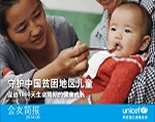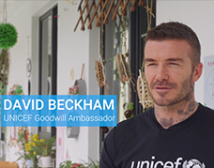Vaccines keep children alive and healthy by protecting them against disease. Yet in 2016, an estimated 1.4 million children under five died from vaccine-preventable diseases. Approximately one-fourth of deaths among children under 5 were from pneumonia, diarrhoea and measles, and could have been mostly prevented by vaccines. Globally 1 in 7 children – over 19 million – missed out on routine vaccines, including 13 million who have never been vaccinated, putting them and their communities at risk of disease and death. Low immunization coverage compromises gains in all other areas of health for mothers and children. The poorest, most vulnerable children who need immunization the most continue to be the least likely to get it.
UNICEF and its partners are working to ensure that the lives of all children are protected. But, if vaccination is not prioritized, some of the most marginalized children will miss out on their right to benefit from immunization, which could mean the difference between life and death.
|

©UNICEF/China/2018/Ma Yuyuan
In March 2018, a child was receiving vaccination in Yulong county's health center. |
Despite these challenges, vaccines are protecting more children than ever before. Behind their phenomenal success lies the hard work of health workers who go from village-to-village to vaccinate children, even though they encounter fear and suspicion.
“Last year, it is estimated that vaccines saved the lives of as many as 3 million children. That's 3 million future doctors, teachers, artists, community leaders, mothers and fathers alive today thanks to millions of frontline health workers who walk for hundreds of miles to remote locations, through jungles and across seas to reach every child,” said Robin Nandy, UNICEF's Chief of Immunization. “We continue to work with governments on the ground, including in places affected by conflict, in support of these unsung heroes who take on this extremely dangerous work to save lives.”
Twelve key facts on vaccines today
-
Two-thirds of unvaccinated children live in fragile countries or those affected by conflict. Between 2010 and 2016, Syria saw the sharpest decline in vaccinated children, with coverage*[i]falling by 38 percentage points over this period. Second is Ukraine where coverage decreased by 33 percentage points.
-
A number of countries have seen a significant increase in the number of vaccinated children since 2010, driving most of the gains in immunization coverage this decade, including India, Ethiopia, Democratic Republic of the Congo, Bangladesh, Philippines, Mexico, United Republic of Tanzania, Vietnam, Turkey and Sudan. In India, the number of unvaccinated children[ii] reduced by 45 per cent, from 5.3 million in 2010 to 2.9 million in 2016.
-
As of 2016, six countries accounted for half of the world's unimmunized children*: Nigeria (18%); India (15%); Pakistan (7%); Indonesia (5%); Ethiopia (4%); and Democratic Republic of the Congo (3%).
-
The top 10 countries where vaccination coverage*, in percentage points, has increased between 2010 and 2016 are Palau (29%), Malta (21%), Democratic Republic of the Congo (19%), Comoros (17%), Azerbaijan (16%), Ethiopia (16%), Timor-Leste (13%), Barbados (11%), Costa Rica (9%) and India (9%).
-
In 2017, Yemen witnessed one of the worst cholera epidemics on record with over a million suspected cases, almost 29 per cent of them among are children under five. Around 5.2 million people received two doses of the oral cholera vaccine in South Sudan, Somalia, Mozambique, Malawi, Sierra Leone, Philippines, Nigeria, Chad, Haiti, Cameroon, Zambia and Bangladesh during cholera outbreaks or as part of preventive campaigns.
-
Diphtheria, a disease that is only rarely seen thanks to immunization, is making a come-back. In response to an outbreak among Rohingya refugees – in which three out of four people affected were children – UNICEF
supported several large vaccination campaigns in southern Bangladesh, reaching close to half a million children.
-
In 1988, there were 350,000 cases of polio a year. Since then, over 2.5 billion children have been vaccinated against the disease. Today, the world is closer than ever to eradicating polio, with only 22 cases in two countries last year. More than 400 million children will be vaccinated this year.
-
The lives of an estimated 20 million children have been saved through measles immunization between 2000 and 2016.
-
A billion people will be vaccinated against Yellow fever in Africa by 2026 - almost half of them children under 15 years of age. Since 2001, the production of the yellow fever vaccine has quadrupled from 20 million to 80 million doses annually, and is expected to increase in the coming years.
-
As of 2016, an estimated 86 per cent of children less than one year of age were fully vaccinated against diphtheria, tetanus and pertussis, compared to 52 per cent some 30 years ago.
-
In 2017, UNICEF procured 2.4 billion vaccine doses worth $1.3 billion, reaching 45 per cent of the world's children.
-
Thanks to vaccines, maternal and neonatal tetanus, which is extremely deadly amongst newborns, has been eliminated in all but 15 countries. Ethiopia, Haiti and Philippines eliminated the disease in 2017.
In China, the country has achieved many goals through its national immunization program, including being declared polio free in2000 and reducing by 90% chronic hepatitis B infection among young children. After polio cases reemerged in 2011 following an importation of poliovirus, China stopped the outbreak in record time. In 2012, WHO verified that China had eliminated neonatal and maternal tetanus, and that same year, China licensed the world's first hepatitis E vaccine.
|

©UNICEF/China/2018/Ma Yuyuan
In March 2018, a child was receiving vaccination in Yulong county's health center. |
Yet there are still critical coverage gaps, especially for migrant workers and their children. Additionally, to achieve world-best standards of expanding vaccination coverage, China needs to add Haemophilus influenzae type b (Hib), Pneumococcalconjugate vaccine(PCV) and rotavirus to the national program.
i. Coverage is measured by the percentage of infants receiving all three required doses of diphtheria-tetanus-pertussis-containing vaccine.
ii. Number of children receiving all three required doses of diphtheria-tetanus-pertussis-containing vaccine.
######
The data is based on WHO/UNICEF estimates of national immunization coverage (2016 revision). Click here for more information.
Download photos and videos here
About UNICEF
UNICEF works in some of the world's toughest places, to reach the world's most disadvantaged children. Across 190 countries and territories, we work for every child, everywhere, to build a better world for everyone. For more information about UNICEF and its work for children visit www.unicef.org.
For more information, please contact:
Sabrina Sidhu, UNICEF New York, +19174761537, ssidhu@unicef.org
Kathryn Irwin, Chief of Communication, UNICEF China, Tel: 8610 8531 2610, Email: kirwin@unicef.org































